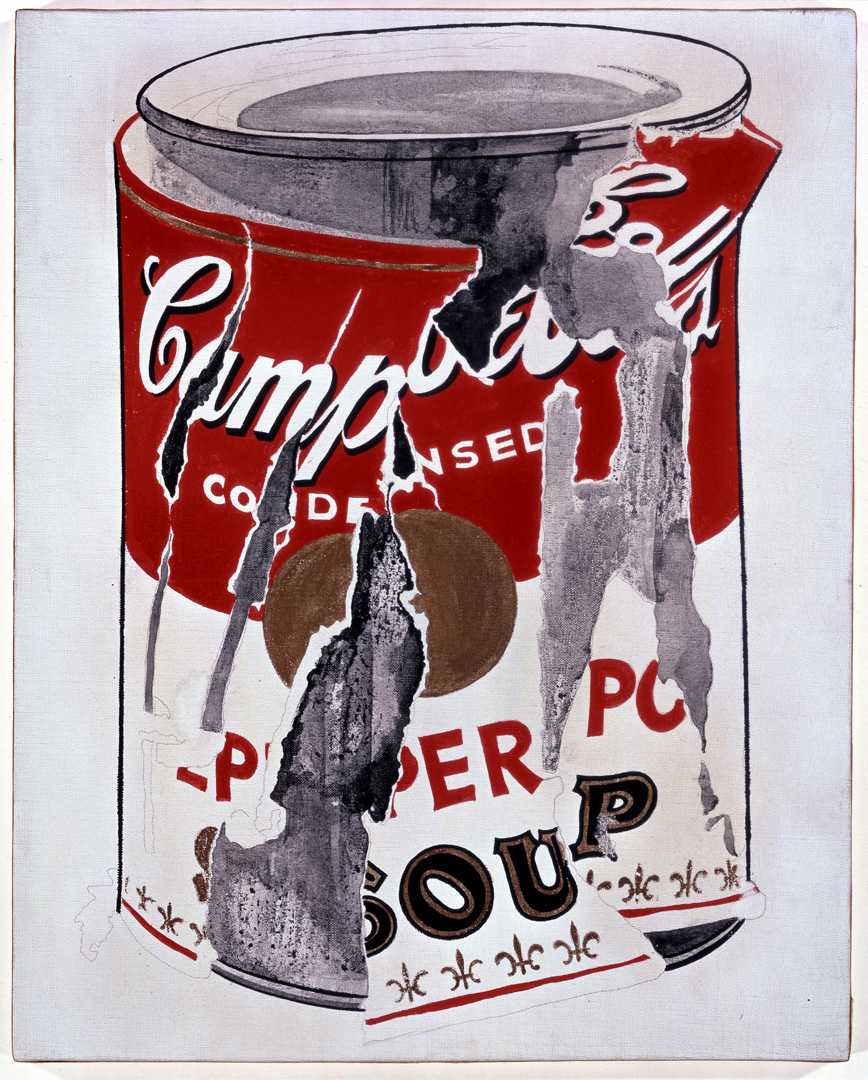
Small Torn Campbell's Soup Can (Pepper Pot)
© The Andy Warhol Foundation for the Visual Arts/Artists Rights Society (ARS), New York
[AUDIO: vintage Campbell’s ad jingle, men and women singing together,
“Sit right down, and get your Campbell’s worth!”]
NARRATOR
Andy Warhol claimed he ate a can of soup every day. For 20 years.
He certainly appreciated uniformity. When Warhol first exhibited his famous Soup Can paintings, the gallery displayed them in tidy rows on shelves. The grocery store next door put up a sign advertising that they sold REAL soup cans, and for only 29 cents!
NARRATOR
Edye Broad.
EDYE BROAD
I saw the Warhol show at the Ferus Gallery in 1962, and I remember thinking the soup cans would look cute in my kitchen! But I thought Eli would have me committed if I spent $100 on a picture of a soup can. Now he really wishes I had bought one.
NARRATOR
Warhol made many paintings of cans with their labels intact. These were not precious masterpieces but instead easily reproducible efforts, a mirror of the machine of American consumer culture.
[SOUNDFX: child’s voice saying “MM! Yummy!”, mechanical sounds, ending in paper tearing.]
NARRATOR
But the act of tearing something is unique by its very nature, and Warhol made only six of these torn label paintings.
Irving Blum, director of the Ferus Gallery.
IRVING BLUM ARCHIVAL
That’s a lot of painting, you know. They’ve always seemed to me to be kind of bridge paintings, between first generation, abstract expressionism and the and the pop style. I think of them that way.
NARRATOR
It shows off Warhol’s painterly handiwork, an ironic gesture in the age of mechanical reproduction by an artist who called his studio “The Factory.”
“Everybody has their own America, and then they have the pieces of a fantasy America that they think is out there but they can’t see.” – Andy Warhol
Andy Warhol was born Andrew Warhola in Pittsburgh, Pennsylvania. His parents had immigrated to the United States and settled in an Eastern European enclave in the city. Warhol’s mother was an artist as well, and after he moved to New York in 1949, she would follow him. They lived together until her death.
Throughout the 1950s, Warhol worked as a commercial illustrator. By the early 1960s, he began to develop his iconic Pop style. As a leading figure of Pop art, Warhol brought the imagery and techniques of mass commercialism into the visual arts, moving away from abstract expressionism, the dominant movement that touted universal appeal and a unique brand of American freedom. Warhol’s work showed another side of America. His paintings of Coca-Cola bottles and Campbell’s soup cans highlighted the wide-spread recognition of these products through slick advertising. Early works were painted by hand, the images often traced from projection in order to appear as if mechanically produced. In 1962 Warhol began to create silkscreen prints, the medium he is best known for.
While the artist’s hand is not visible as brushstrokes in his photo-silkscreened works, Warhol’s choices—of content, cropping, color, and, in some instances, manipulation of the photographic source image—are integral to his process. Through these choices Warhol drew on themes of celebrity, death, disaster, and commodity, often read as metaphor for American culture. In his celebrity portraits and self-portraits, some see religious icons as inspiration; Warhol was Catholic, and he remained religious throughout his life.
Warhol was skillfully ambiguous, and his work is interpreted as both celebratory and critical. From his artwork, ranging from painting and sculpture to film, to his studio (The Factory), which became a flashpoint for 1960s counterculture, to his infamous celebrity persona, Warhol was deeply influential during his lifetime, and his influence on younger generations of artists is difficult to overstate.